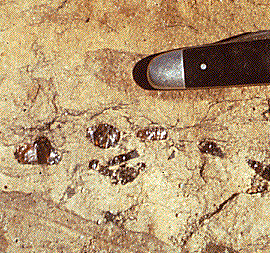Amber
Fossils: Window to the pastAmberWhat is amber?Amber is fossilized resin of a coniferous tree of early Tertiary. One of the differences between resin and sap is the latter's solubility in water since most of it is water from the xylem (water transporting system) of the tree. In this type of fossilization, the organism is entrapped
in a biologically inert environment and preserved as a whole. Intact insects are often found in amber, though they may be altered slightly.
The process of amber formationOrganisms fall or drop into the resin when it first exudes out of the tree. Essential oils, called Oleoresins, compose most of the first deposited resin. This substance is volatile and is often lost through the years. Additional resin then falls on top and gives the organism its typical suspended appearance. The resin then hardens through a process called polymerization and becomes less vulnerable to destruction. This hardened resin, called copal, has a higher chance of being fossilized than pliable resin. As the copal ages, concentration of the essential oil decreases while the copal progressively oxidizes the resin and polymerization continues. The copal slowly turns into amber millions of years after the first entombment of the organism. The only way to differentiate between the two elements would be to put them through many physical and chemical tests such as UV light testing, burning, and various other tests. The most famous examples of amber have come from the Baltic Sea region (Germany, Poland, Lithuania, Denmark, the former Soviet Union, Great Britain, Estonia, Latvia, and Holland). Because of the presence of microscopic air bubbles, Baltic amber tends to appear cloudy or milky. The hue varies with quantity and quality of the bubbles. |
 Many physical and chemical agents of abiotic environment (the oxidative
air and temperature) and biotic factors (bacteria and scavengers)
accelerate the decomposition of a dead organism. Avoidance of these factors
aids in preserving the organism and in the amber formation.
Many physical and chemical agents of abiotic environment (the oxidative
air and temperature) and biotic factors (bacteria and scavengers)
accelerate the decomposition of a dead organism. Avoidance of these factors
aids in preserving the organism and in the amber formation.